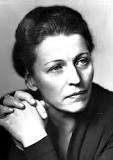Pearl S. Buck (26 June 1892 – 6 March 1973): The Good Earth-China
BIOGRAPHIES, 26 Jun 2017
Rene Wadlow – TRANSCEND Media Service
 Pearl S. Buck is with irony the best known writer on Chinese rural life. Ironic, because those in the Chinese government dealing with cultural issues would prefer that a Han Chinese be better known as an interpreter of Chinese rural life than the American Nobel laureate for Literature of 1938. After the Second World War, when she was living in the USA, anything dealing with China was considered as potentially Communist, and the FBI kept close watch on her contacts and writings. Henry Luce, publisher of Time magazine, and also a child of missionaries in China, banned her name from being mentioned in its pages.(1)
Pearl S. Buck is with irony the best known writer on Chinese rural life. Ironic, because those in the Chinese government dealing with cultural issues would prefer that a Han Chinese be better known as an interpreter of Chinese rural life than the American Nobel laureate for Literature of 1938. After the Second World War, when she was living in the USA, anything dealing with China was considered as potentially Communist, and the FBI kept close watch on her contacts and writings. Henry Luce, publisher of Time magazine, and also a child of missionaries in China, banned her name from being mentioned in its pages.(1)
Pearl Buck grew up in China, the only living child of an American Presbyterian missionary couple. Her father, Absalom Sydenstricker represented the narrow wing of missionary effort believing that a Chinese convert to Christianity had to leave behind all his beliefs and rituals. Many Chinese make a happy mixture of Taoist, Buddhist, Confucian elements with a strong touch of nature worship. They are willing to add Jesus to the host of immortals but not as a figure to the exclusion of all the others. Thus, he produced few converts but plenty of frustration. Buck’s book Fighting Angel (1936) is based on the life of her father.
In part to escape from a family circle heavy with frustration and anger, just after her university studies in the USA, she married John Lossing Buck, an American agricultural economist, stationed in China. His writings on rice production and other Chinese crops were well know in the 1930s-1940s.(2) From him and her observations of rural life during his field trips, Pearl Buck learned a great deal of the technical aspects of Chinese agriculture. Unlike her husband, she also had a deep insight into the thinking and social relations of Chinese farmers.
The elder of Pearl Buck’s two daughters was mentally handicapped and was taken at age 9 by Pearl Buck to a mental institution in the USA, there being few, if any, mental institutions for children in China. In order to pay for the upkeep of her daughter and as a focus for her life, she started writing, “chaining herself to her desk” as she said. John Buck, who had not thought that he needed a “chained-writing wife” took a younger Chinese woman. Although two wives for those that could afford it was then common in Chinese society, it was not acceptable in American missionary circles. Pearl and John divorced. Later, when living in the USA, she married the publisher of her books, John Day.
The Good Earth of 1931 was followed by 39 novels, 25 works of nonfiction and a host of short stories and articles. The Good Earth is still the best-known of her books and contains many of the elements of her later China-focused fiction: relations within a family, love of the land, the impact of famine when crops fail due to the weather, bandits, marauding soldiers and a mentally-handicapped daughter.
Pearl Buck was a cultural bridge-builder, bringing an understanding of Chinese rural culture to the USA and Europe, but also to Chinese urban society as at different times her books, translated into Chinese, were widely read in China. In the 1950s-1960s she was active in helping children in South Korea fathered by US soldiers and then left behind. She remained highly sensitive to the hurts of children in early age, one of the themes of her novels. With renewed attention being given to China, Pearl Buck’s writing merit special attention.
NOTES:
(1) Peter Conn. Pearl Buck: A Cultural Biography (Cambridge University Press)
Hilary Spurling. Pearl Buck in China (Simon and Schuster)
(2) John Lossing Buck. Chinese Farm Economy (University of Chicago Press,1930)
John Lossing Buck. Land Utilization in China (University of Chicago Press,1937)
___________________________________________
 René Wadlow is a member of the Fellowship of Reconciliation’s Task Force on the Middle East, president and U.N. representative (Geneva) of the Association of World Citizens, and editor of Transnational Perspectives. He is a member of the TRANSCEND Network for Peace, Development and Environment.
René Wadlow is a member of the Fellowship of Reconciliation’s Task Force on the Middle East, president and U.N. representative (Geneva) of the Association of World Citizens, and editor of Transnational Perspectives. He is a member of the TRANSCEND Network for Peace, Development and Environment.
This article originally appeared on Transcend Media Service (TMS) on 26 Jun 2017.
Anticopyright: Editorials and articles originated on TMS may be freely reprinted, disseminated, translated and used as background material, provided an acknowledgement and link to the source, TMS: Pearl S. Buck (26 June 1892 – 6 March 1973): The Good Earth-China, is included. Thank you.
If you enjoyed this article, please donate to TMS to join the growing list of TMS Supporters.

This work is licensed under a CC BY-NC 4.0 License.